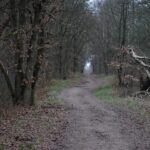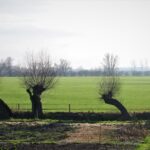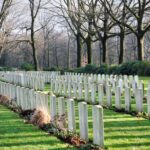I confess I am more interested in ancient history than modern. My husband, however, has a passion for World War II. A few years ago, we joined my parents on a tour of the beaches at Normandy. I learned a lot and found it very interesting. But I didn’t come home and do further research.

This year, for Dave’s birthday, I booked a tour of the Battle for Arnhem in The Netherlands. I knew it was somewhere he wanted to go while we were still in Europe. While I had seen the movie, A Bridge Too Far, I kept my mouth shut to learn what actually happened and to see how much of the film was accurate. So, I found The Battlefield Explorer Tours online at https://thebattlefieldexplorer.com/, and we were set. Our guide, Joris Nieuwint, was very knowledgeable, and I enjoyed learning about those September days in 1944.
German troops were retreating following D-Day in June as Allied forces pressed forward across France, Belgium, Luxembourg, and The Netherlands. But the Allied supply lines were stretched thin as they approached the German border. They needed to do something to shorten the war.
British Field Marshal Montgomery devised a strategy to bypass the defenses along the Siegfried Line, cross the lower Rhine River, and march into the Ruhr Valley, the industrial heart of Germany. It was a daring plan, and I’m sure you’ve heard the expression, ‘it looks good on paper.’
The code name for the project was Market Garden. Market referred to the airborne assault by three Allied airborne divisions: the U.S. 101st Airborne, the U.S. 82nd Airborne, and the British 1st Airborne. These divisions would drop by parachute and glider over the next three days into Eindhoven, Nijmegen, and Arnhem in The Netherlands. Their mission was to seize strategic areas and bridges for the XXX Corps ground forces to cross the river and ultimately enter Germany. The ground assault, composed of XXX Corps, was code-named Garden.

On the morning of 17 September, the three airborne divisions flew across the North Sea. Their mission? The 101st was to capture Eindhoven and secure the bridges over the canals and rivers. The 82nd was to seize the territory around Nijmegen, including the bridge over the Waal river. The 10,000 men of the British 1st, along with the 1st Polish Independent Parachute Brigade, had the daunting task of capturing and holding the bridge over the Rhine at Arnhem.
Unfavorable circumstances impeded the project from the beginning. Despite the courage and bravery of the people involved, the odds of achieving their goals seemed stacked against them.
Because of intelligence reports of German anti-aircraft guns around Arnhem, the landing sites selected were eight miles away from where they needed to land. These locations proved to be too far away from their goal. Only a single battalion of the 1st Airborne reached the Arnhem bridge.
Since limited aircraft were available to transport the forces, the drops at each location took three days to complete. So much for the element of surprise, which lessened the impact.
Just before the start, Dutch resistance reports of two German Panzer divisions in the area were ignored by the Allied commanding officers. The II S.S. Panzer Korps under Sturmbannführer Sepp Krafft was in the area conducting training, as well as Heeresgruppe B, commanded by Feldmarschall Walther Model. These men saw the parachutes and gliders and wondered why the Allies would be assaulting Arnhem. Feldmarschall Model believed they were coming for him and sent his forces against them on their eight-mile trek toward their target.
The wooded areas and distance between the battalions made matters worse. The radios, vital for coordination, did not work. This failure made it difficult, if not impossible, for Major-General Urquhart, Commander of the British 1st Airborne Division, to organize any offensive. There had been doubts about the ability to communicate before leaving England, and Urquhart reportedly called it a suicide mission.
Weather interfered with progress as well. Dense fog in England forced the postponement of later flights, including the 1st Polish Independent Parachute Brigade. Near Arnhem, heavy clouds halted the transport of troops and supplies vital for the forces fighting to hold Arnhem Bridge.

And if all that wasn’t enough, the ground forces were held up by less-than-ideal conditions on the road, which was narrow and only wide enough for two vehicles. The German infantry picked off the nine leading British tanks right at the start, and the troops covered only seven miles on the first day. While they managed to cover twenty miles on the second day, catching up with the U.S. forces in Eindhoven, they were still far from their target of reinforcing the British in Arnhem. The retreating Germans had blown up the bridge at Son, requiring temporary repairs. Afterward, the joint forces met strong resistance from the Germans.
Further landings by the 4th Parachute Brigade, British 1st Airborne Division, were held up by unexpected German defenses, which proved too strong. On the 19th, the 1st Airborne Division could not break through to relieve the paratroopers holding the bridge in Arnhem and fell back to the village of Oosterbeek to attempt to hold the town.
Unable to hold out any longer, after their valiant effort, the 2nd Battalion, Parachute Regiment, under the command of Lieutenant Colonel John Frost, was forced to surrender on the 21st. They were out of ammunition and supplies. They were surrounded.

On the night of the 25th, as their perimeter shrank, the troops in Oosterbeek were ordered to retreat. Those who stayed behind, non-walking wounded, medical staff, and radio operators operated the guns, so it appeared all was normal inside the town. The brave fighters slipped out of town across the flood plain and rowed across the river in Operation Berlin. Many were lost, and many were captured.

While the 101st Airborne Division, landing in Eindhoven, was successful in capturing the bridge there, and the 82nd Airborne Division successfully captured their target, the overall mission of providing a pathway into Germany hoping to shorten the war failed.
On our tour, we visited most of the sites, from the landing zones to Oosterbeek to the bridge at Arnhem. The efforts of the 2nd Battalion Parachute Regiment severely damaged the bridge, which was later bombed by Allied aircraft. The one standing today is the third bridge over the Rhine River.

Great article. Very informative.
Thank you, Dave!
A very informative article that accurately describes the events of that attempt. If I recall the film wasn’t too far off track, when you exclude the bits and pieces added for dramatic effect It points out the cluster of events that spelled failure. Some caused by nature and some by human error.
Thank you. And I agree, the movie seems to be fairly accurate.